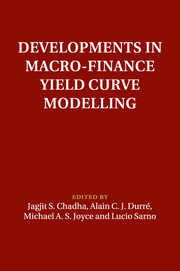Bond Pricing and Yield Curve Modeling
In this book, well-known expert Riccardo Rebonato provides the theoretical foundations (no-arbitrage, convexity, expectations, risk premia) needed for the affine modeling of the government bond markets. He presents and critically discusses the wealth of empirical findings that have appeared in the literature of the last decade, and introduces the 'structural' models that are used by central banks, institutional investors, sovereign wealth funds, academics, and advanced practitioners to model the yield curve, to answer policy questions, to estimate the magnitude of the risk premium, to gauge market expectations, and to assess investment opportunities. Rebonato weaves precise theory with up-to-date empirical evidence to build, with the minimum mathematical sophistication required for the task, a critical understanding of what drives the government bond market.
- Presents a treatment of term-structure modeling that includes both the real-world and risk-neutral measures, allowing the reader to ask fundamental questions about bonds
- Critically discusses important models used by practitioners, central bankers, academics, and investors, enabling the reader to understand why these models give different answers, and encouraging them to devise their own models
- Minimal mathematics allows the reader to concentrate on the economic and financial content of the model, rather than mathematical equations
Reviews & endorsements
'Rebonato has produced a unique and intensely engaging treatment of modern dynamic yield curve modeling: where we've been, where we are, where we're going, and why. Without slipping into spineless eclecticism - indeed he stays far from it, emphasizing a structural approach throughout - he beautifully blends rigor with penetrating intuition, seriousness of purpose with entertaining quips and quotes, historical awareness with forward-looking insight, and crucially, statistics with theory.' Francis X. Diebold, University of Pennsylvania
'I have been waiting for Riccardo to write this book for years, and finally the wait is over! This book represents a brilliant combination of theory and practice as used by practitioners in a lucid yet rigorous manner. I can confidently say that the depth of perception that this book brings will be indispensable for anyone interested in understanding bonds and the yield curve, especially in today's market environment.' Vineer Bhansali, LongTail Alpha
'Rebonato's book integrates practical aspects of yield curve investing with the most up-to-date research. It is a superb synthesis for anyone interested in rigorous analysis of these capital markets, which are among the most important globally.' Ian Cooper, London Business School, University of London
'Rebonato takes readers on a thought-provoking journey that will elevate their thinking about term-structure modeling. In this journey, they will likely become increasingly familiar and comfortable with some simple mathematical techniques that are new to them.' Enterprising Investor, CFA Institute (www.blogs.cfainstitute.org)
Product details
July 2018Hardback
9781107165854
776 pages
234 × 155 × 40 mm
1.28kg
Available
Table of Contents
- Part I. The Foundations:
- 1. What this book is about
- 2. Definitions, notation, and a few mathematical results
- 3. Links between models, monetary policy, and the macroeconomy
- 4. Bonds: their risks and their compensations
- 5. The risk factors in action
- 6. Principal components: theory
- 7. Principal components: empirical results
- Part II. The Building Blocks – A First Look:
- 8. A preview – a first look at the Vasicek model
- 9. Expectations
- 10. Convexity – a first look
- Part III. No Arbitrage:
- 11. No arbitrage in discrete time
- 12. No arbitrage in continuous time
- 13. No arbitrage with state price deflators
- 14. No-arbitrage conditions for real bonds
- 15. The links with an economics-based description of rates
- Part IV. Solving the Models:
- 16. Solving affine models: the Vasicek case
- 17. First extensions
- 18. A general pricing framework
- 19. The shadow rate: dealing with a near-zero lower bound
- Part V. The Value of Convexity:
- 20. The value of convexity
- 21. A model-independent approach to valuing convexity
- 22. Convexity: empirical results
- Part VI. Excess Returns:
- 23. Excess returns: setting the scene
- 24. Risk premia, the market price of risk, and expected excess returns
- 25. Excess returns: empirical results
- 26. Excess returns: the recent literature – I
- 27. Excess returns: the recent literature – II
- 28. Why is the slope a good predictor?
- 29. The spanning problem revisited
- Part VII. What the Models Tell Us:
- 30. The doubly-mean-reverting Vasicek model
- 31. Real yields, nominal yields, and inflation: the D'Amico–Kim–Wei model
- 32. From snapshots to structural models: the Diebold and Rudebush approach
- 33. Principal components as state variables of affine models: the PCA affine approach
- 34. Generalizations: the ACM model
- 35. An affine, stochastic-market-price-of-risk model
- 36. Conclusions
- 37. References.








